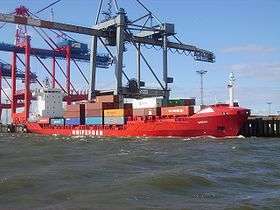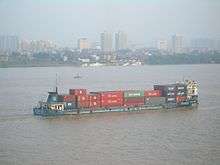Feeder ship

Feeder vessels or feeder ships are ships of various sizes, but mostly understood to be seagoing vessels with an average capacity of carrying 300 twenty-foot equivalent units (TEU) to 1000 TEU. Feeders collect shipping containers from different ports and transport them to central container terminals where they are loaded to bigger vessels or further transport by truck or rail into the hub port's hinterland. In that way the smaller vessels feed the big liners, which carry thousands of containers. Over the years, feeder lines have been established by organizations transporting containers over a predefined route on a regular basis. Feeder ships are often run by companies that also specialize in short sea shipping. These companies not only ship freight to and from ports like Rotterdam for further longhaul shipment, but also carry containers between smaller ports, for example, between terminals located on the north-west European seaboard and ports situated on the Baltic Sea coastline.

Great Lakes
While container shipping is currently uncommon on the Great Lakes, a proposal for shipping containers from the port of Oswego on Lake Ontario in upstate New York down the Saint Lawrence Seaway for transfer to larger ocean-going ships at Melford International Terminal in Nova Scotia has been (2008) considered.[1]
Feeder Class
Container ships are distinguished into 7 major size categories: small feeder, feeder, feedermax, panamax, post-panamax, new panamax and ultra-large.[2] Container ships under 3,000 TEU are generally called feeders, and operate as above.
References
- ↑ "Oswego Considered For Major Container Port: Plan calls for $3M facility to create first Great Lakes site handling global container shipments", by John Doherty. Wednesday, October 22, 2008
- ↑ MAN Diesel, 2009, p.6.
| Wikimedia Commons has media related to Feeder ships. |
